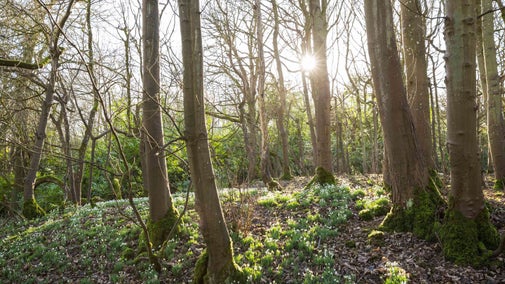
Donate
Everyone needs nature, now more than ever. Donate today and you could help people and nature to thrive at the places we care for.

Although the large house that once stood at Drovers Estate was completely destroyed by 1815, there’s still plenty to see and do here in this hidden estate in the valleys of the South Downs. The mixture of habitats, encompassing rolling hills, ancient woods and disused railway tunnels, provides a home to a wide diversity of flora and fauna.
The former railway between Chichester and Midhurst opened in 1881, with the railway line and station passing through Drovers Estate and Singleton village.
The station was built in a grand design to accommodate visitors to Goodwood racecourse but the line eventually closed. The tunnels are now inaccessible and are legally protected bat roosts.
Many of the remaining farm buildings and barns retain local building styles and haven’t changed much over time.
Drovers’ woods contain some impressive old beech pollards, areas of hazel and oak, and carpets of woodland anemones in spring.
Early purple orchids and butcher's broom – a spiky evergreen shrub once used to clean butcher's meat tables – are also found here.
Drovers is all about being on a less trodden path through a range of habitats, woodland trails and open views. You can enjoy circular walks by following the waymarked permissive routes.

The hedgerows here provide cover and an abundance of berries for birds to feed on in the autumn, and the grassland insects offer up a veritable feast.
The estate is also a hot spot for kestrels and red kites, so keep an eye out on the sky as you enjoy your walk.
Hat Hill is a special area of chalk downland. Its steep slope means that it was never ploughed or cultivated, allowing it to be grazed by deer and livestock. It has remained a wild and natural open area rich in flowers and insects, which in turn is perfect for butterflies.
Marbled whites, skippers and blue butterflies proliferate here in the height of summer.

As West Sussex is one of the most wooded areas in the country, the number of bat species here is particularly high. At Drovers Estate, the blend of woodland, hedgerows, scrub and old buildings provides a great habitat for them. The trees provide roosting sites while large hedgerows and rough grass are ideal for them to find food in.
Beside the old railway tunnel in late summer is a hotspot for bat species including pipistrelle, long-eared, whiskered and natterer's bats.
For more information on these fascinating creatures visit the Bat Conservation Trust website.

Everyone needs nature, now more than ever. Donate today and you could help people and nature to thrive at the places we care for.
The places we look after are home to every kind of bat that lives in the UK. Use our handy guide to identify different species and find out where to spot them.

Learn how we protect the bat populations that live at places we look after, as part of our core values as a conservation charity.

Experience a landscape shaped by traditional rural life

Plan a visit to one of the special countryside places in our care and discover the benefits of being in the great outdoors. Pack your walking boots and get ready to explore woodlands, valleys and rivers.

Discover the wide array of countryside settings around Sussex, from the highest point of East Sussex at Ditchling Beacon to the incredible rolling landscape of the South Downs.

Explore some of the finest landscapes in our care on coastal paths, accessible trails, woodland walks and everything in between. Find the best places to walk near you.
